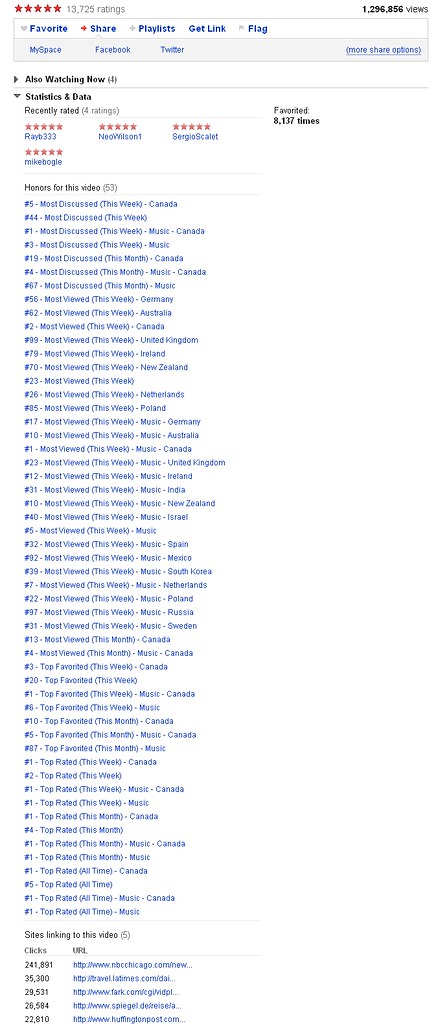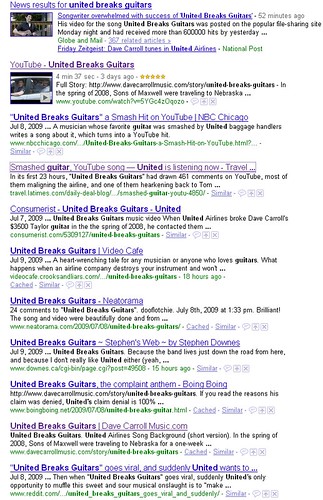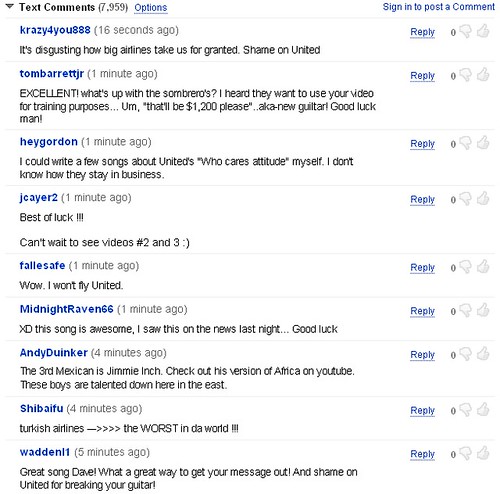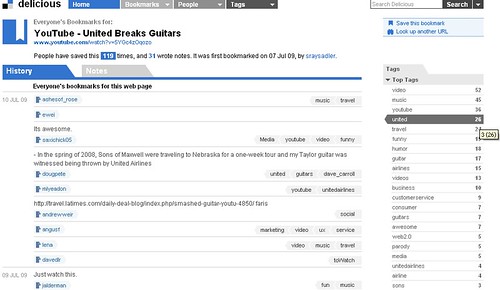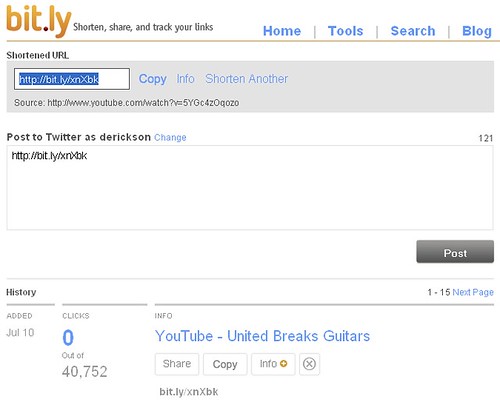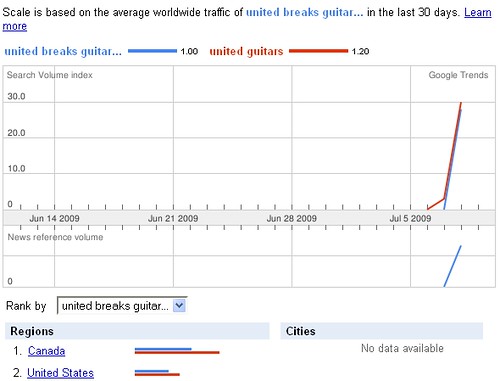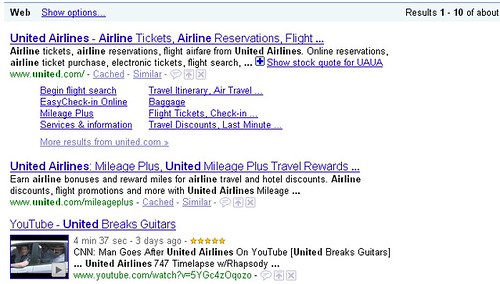Dave Carroll is a musician spurned…by United Airlines…who broke his guitar. His $3500 Taylor guitar. And they refused to take responsibility for it. Read Carroll’s story at his Web site.
After being given endless run-arounds and finally being told he would not be compensated for the damage United’s employees inflicted upon his instrument, he did what he knew. He wrote a song; the first of three he vowed to create to carve out his pound of flesh.
And he did what any self-respecting, YouTube-wielding musician would do: He uploaded it to ensure as many people as possible would see it.
This is the first of Carroll’s musical trilogy:
Four days later, Carroll’s video was a hit.
As you can see from the screenshot below, as of this writing the video on YouTube alone has garnered nearly 1.3 million views, has an average 5 star rating from 13,725 people, has been favorited by more than 8,000 people, has shot up the YouTube charts overall and in countries in which United does business, and has been embedded or linked to by such top media outlets as NBC, The LA Times, Der Spiegel, and the Huffington Post.
From these stats, it looks like the mainstream media either heard about this story from Carroll himself, or they got wind of the video online and picked it up. That coverage then drove people to the Web to view the video online, further pushing up its popularity. The following graph shows the spike in search traffic for the phrases “united breaks guitars” and “united guitars:”
And what they saw after they searched was a branding disaster for United:
Your brand is what people say it is and in the age of the social Web, it is what people say it is, writ large.
Misery loves company, so when people found the video at YouTube they both encouraged Carroll in his quest for revenge and they shared their dislike of the airline industry in general or United in particular. As of this writing, nearly 8,000 people have left comments:
Another typical behavior in such cases is the sharing of content. This often happens through email but until the advent of the social Web, we had no way to really measure that activity. Now we’ve got social bookmarking sites like Delicious where we can get an inkling of how share-worthy content is.
Though this screenshot shows that 119 users saved the YouTube video to their Delicious accounts, keep in mind that Delicious users are particularly Internet-savvy and likely have multiple channels of distribution, so if they save something to Delicious, it’s probably going to their Twitter feed, their Facebook page, their FriendFeed, etc.
We’ve also got Twitter, and through the URL shortening service bit.ly, we can gain some insight into how many of their users shared the video with their Twitter followers: more than 40,000:
When people share content through their social network, it is much more likely to be consumed because it comes from a trusted source. And because social networks make it so easy to share content, word spreads effortlessly.
At some point, a Groundswell such as this creates an ambient awareness of the issue. People may not know the specifics but through a combination of online references, glimpses on traditional media, or through direct word of mouth, they find out about it.
These people tend to search to find out what everyone is talking about; combine that with those who saw it on TV or heard about it on radio and want to watch the video directly, and you’ve got a search spike:
More damaging to United, though, is the lasting branding issues that will linger after the initial wave of interest blows over. A search for “united” demonstrates this damage:
Because the listing for the YouTube video includes a graphic, the eye is drawn directly to it, so they will be aware of this issue when they search for the company if they hadn’t already heard about it. If they had already heard about this incident, it just reinforces the negative message that not only does United break guitars, they don’t care if they do and there’s not a damn thing you can do about it.
At least they think so.
During all of this, United appears to be silent. To their credit, they’ve been responding to the crisis on their Twitter account. On July 7, they responded to @Kelly_MacD‘s post about the video, saying they have contacted Carroll and are trying to resolve the issue. Then, two days ago, they said they want to use Carroll’s video for training purposes, but it took three days for United to actually say they were sorry.
Those two words–we’re sorry–are the first step toward addressing this crisis. Why does is it so hard for corporations to bring themselves to acknowledge fault?
Acknowledge the issue, apologize for your mistake, and rectify the issue.
But a problem still remains for United. Those pesky search results; their Twitter activity will have no affect on that. On the real-time Web, speed kills. Even United’s press room, the typical venue in which corporations respond, is silent:
At least a press release would have a decent chance of getting into the search results. Right now, United is out of sight and therefore out of mind in this story. But even then, United would be competing with more than 21,000 blog posts.
A blog post optimized for the phrase “United Breaks Guitars” would have been the ideal response to get their voice into the story…if they had a blog. An optimized YouTube response would be even better…if they had an active YouTube channel.
United has been left flat-footed.
The lessons here are twofold: 1) if you’re a musician, seize opportunities! and, 2) if you’re a corporation, you’ve got to have in place an overall online communications strategy that utilizes the channels that people are already using, so that in part, you’ll have the infrastructure already in place to respond to any crisis that might arise.
This incident is Exhibit A for the need for corporations to include online communications and social media in their overall communications strategy.
The better strategy, of course, is to create a kick-ass product or deliver the absolute best service.
Customer service is the new public relations, folks.
The e-Strategy Academy covers all aspects of digital marketing including search optimization & marketing, email marketing, social media marketing, video marketing, mobile marketing & public relations.
